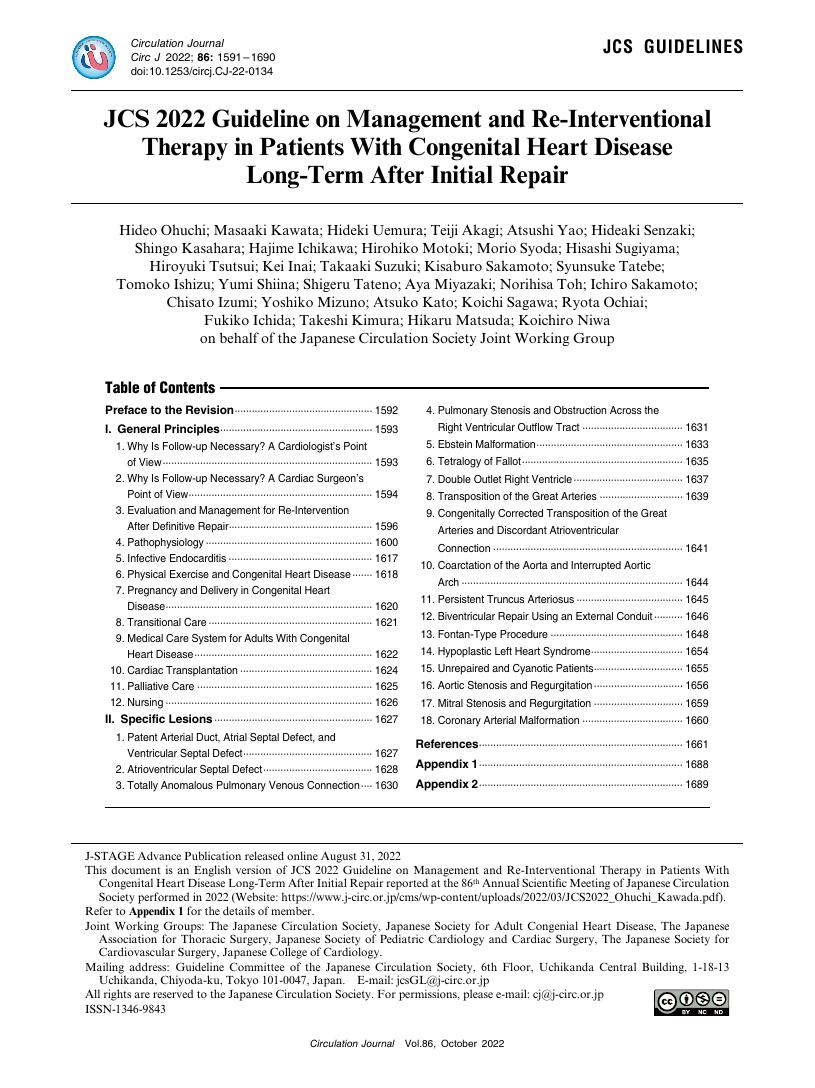- 著者
- Hideo Ohuchi Masaaki Kawata Hideki Uemura Teiji Akagi Atsushi Yao Hideaki Senzaki Shingo Kasahara Hajime Ichikawa Hirohiko Motoki Morio Syoda Hisashi Sugiyama Hiroyuki Tsutsui Kei Inai Takaaki Suzuki Kisaburo Sakamoto Syunsuke Tatebe Tomoko Ishizu Yumi Shiina Shigeru Tateno Aya Miyazaki Norihisa Toh Ichiro Sakamoto Chisato Izumi Yoshiko Mizuno Atsuko Kato Koichi Sagawa Ryota Ochiai Fukiko Ichida Takeshi Kimura Hikaru Matsuda Koichiro Niwa on behalf of the Japanese Circulation Society Joint Working Group
- 出版者
- The Japanese Circulation Society
- 雑誌
- Circulation Journal (ISSN:13469843)
- 巻号頁・発行日
- pp.CJ-22-0134, (Released:2022-08-31)
- 参考文献数
- 1071
- 被引用文献数
- 6
- 著者
- Yoichi Takaya Teiji Akagi Hidehiko Hara Hideaki Kanazawa Yuji Ikari Akihiro Isotani Shinichi Shirai Shunsuke Kubo Takao Morikawa Toru Naganuma Mike Saji Shingo Kuwata Go Hiasa Yusuke Watanabe Masahiro Yamawaki Masao Imai Takashi Matsumoto Masanori Yamamoto Tsutomu Murakami Masahiko Asami Isamu Mizote Tsukasa Okai Hiroki Bota Hiroshi Ito
- 出版者
- The Japanese Circulation Society
- 雑誌
- Circulation Journal (ISSN:13469843)
- 巻号頁・発行日
- pp.CJ-22-0048, (Released:2022-04-05)
- 参考文献数
- 18
- 被引用文献数
- 4
Background: Transcatheter mitral valve repair with the MitraClip system has been established in selected high-risk patients. The MitraClip procedure results in a relatively large iatrogenic atrial septal defect (iASD). This study aimed to investigate the prevalence and clinical course of iASD requiring transcatheter closure following the MitraClip procedure.Methods and Results: This study was conducted at all 59 institutions that perform transcatheter mitral valve repair with the MitraClip system in Japan. The data of patients on whom transcatheter iASD closure was performed were collected. Of the 2,722 patients who underwent the MitraClip procedure, 30 (1%) required transcatheter iASD closure. The maximum iASD size was 9±4 mm (range, 3–18 mm). The common clinical course of transcatheter iASD closure was hypoxemia with right-to-left shunt or right-sided heart failure with left-to-right shunt. Of the 30 patients, 22 (73%) required transcatheter closure within 24 h following the MitraClip procedure, including 12 with hypoxemia and 5 with right-sided heart failure complicated with cardiogenic shock. Of the 5 patients, 2 required mechanical circulatory support devices. Twenty-one patients immediately underwent transcatheter iASD closure, and hemodynamic deteriorations were resolved; however, 1 patient died without having undergone transcatheter closure.Conclusions: Transcatheter iASD closure was required in 1% of patients who underwent the MitraClip procedure. Many of these patients immediately underwent transcatheter iASD closure because of hypoxemia with right-to-left shunt or right-sided heart failure with left-to-right shunt.
- 著者
- Hideo Ohuchi Masaaki Kawata Hideki Uemura Teiji Akagi Atsushi Yao Hideaki Senzaki Shingo Kasahara Hajime Ichikawa Hirohiko Motoki Morio Syoda Hisashi Sugiyama Hiroyuki Tsutsui Kei Inai Takaaki Suzuki Kisaburo Sakamoto Syunsuke Tatebe Tomoko Ishizu Yumi Shiina Shigeru Tateno Aya Miyazaki Norihisa Toh Ichiro Sakamoto Chisato Izumi Yoshiko Mizuno Atsuko Kato Koichi Sagawa Ryota Ochiai Fukiko Ichida Takeshi Kimura Hikaru Matsuda Koichiro Niwa on behalf of the Japanese Circulation Society Joint Working Group
- 出版者
- The Japanese Circulation Society
- 雑誌
- Circulation Journal (ISSN:13469843)
- 巻号頁・発行日
- vol.86, no.10, pp.1591-1690, 2022-09-22 (Released:2022-09-22)
- 参考文献数
- 1071
- 被引用文献数
- 6
- 著者
- Kazufumi Nakamura Toru Miyoshi Satoshi Akagi Norihisa Toh Yukihiro Saito Yoichi Takaya Masatoki Yoshida Koji Nakagawa Satoshi Kawada Hironobu Toda Takashi Miki Rie Nakayama Fumi Yokohama Keishi Ichikawa Masashi Yoshida Makiko Taniyama Nobuhiro Nishii Teiji Akagi Hiroshi Morita Hiroshi Ito
- 出版者
- The Japanese Circulation Society
- 雑誌
- Circulation Journal (ISSN:13469843)
- 巻号頁・発行日
- pp.CJ-22-0349, (Released:2022-06-29)
- 参考文献数
- 3
- 被引用文献数
- 1
The 86thAnnual Scientific Meeting of the Japanese Circulation Society was held in a web-based format on March 11–13, 2022. In accordance with the internationalization policy of the JCS, the meeting was held with the Asian Pacific Society of Cardiology Congress 2022. The main theme was “Cardiology Spreading its Wings”. The number of patients with heart failure and other cardiovascular diseases is increasing dramatically, and the fields dealt with by cardiovascular medicine are also greatly expanding. This conference was both intellectually satisfying and exciting for all participants, who numbered over 14,900. The meeting was completed with great success, and the enormous amount of cooperation and support from all involved was greatly appreciated.
- 著者
- Yasufumi Kijima Teiji Akagi Yoichi Takaya Satoshi Akagi Koji Nakagawa Kengo Kusano Shunji Sano Hiroshi Ito
- 出版者
- The Japanese Circulation Society
- 雑誌
- Circulation Journal (ISSN:13469843)
- 巻号頁・発行日
- vol.80, no.1, pp.227-234, 2015-12-25 (Released:2015-12-25)
- 参考文献数
- 29
- 被引用文献数
- 8 35
Background:A therapeutic strategy in patients with atrial septal defect (ASD) and significant pulmonary arterial hypertension (PAH) remains controversial. This study aimed to assess the effect of PAH-specific medications and subsequent transcatheter shunt closure (ie, a treat and repair strategy) in these patients.Methods and Results:Among 646 patients with ASD, 22 patients (mean age of 56±20 years) who had PAH [mean pulmonary artery pressure ≥25 mmHg and pulmonary vascular resistance (PVR) ≥3 Wood units] underwent successful transcatheter ASD closure. Prior to the procedure, 8 patients received PAH-specific medications (PHM group) and 14 patients did not (non-PHM group). Initially, the PHM group had higher PVR compared with non-PHM group (9.6±3.8 vs. 4.2±1.0 Wood units, P<0.01). After treatment with PAH-specific medications, PVR in this group decreased to 4.0±0.8 Wood units (P<0.01). No adverse events were observed in either the PHM or non-PHM group during or after the transcatheter procedure. In the PHM group, during a treatment period of 52±48 months, the World Health Organization Functional Classification significantly improved (3.0±0.5 to 2.0±0.0, P<0.01), as well as in the non-PHM group (2.1±0.6 to 1.5±0.5, P<0.01).Conclusions:Treat and repair strategy provided substantial improvement and no worsening of the WHO-FC, even in patients with ASD and significant PAH. Long-term hemodynamic follow-up is mandatory to evaluate the ultimate efficacy and safety of this new strategy. (Circ J 2016; 80: 227–234)
